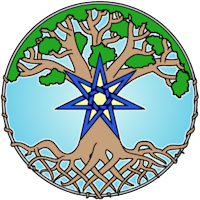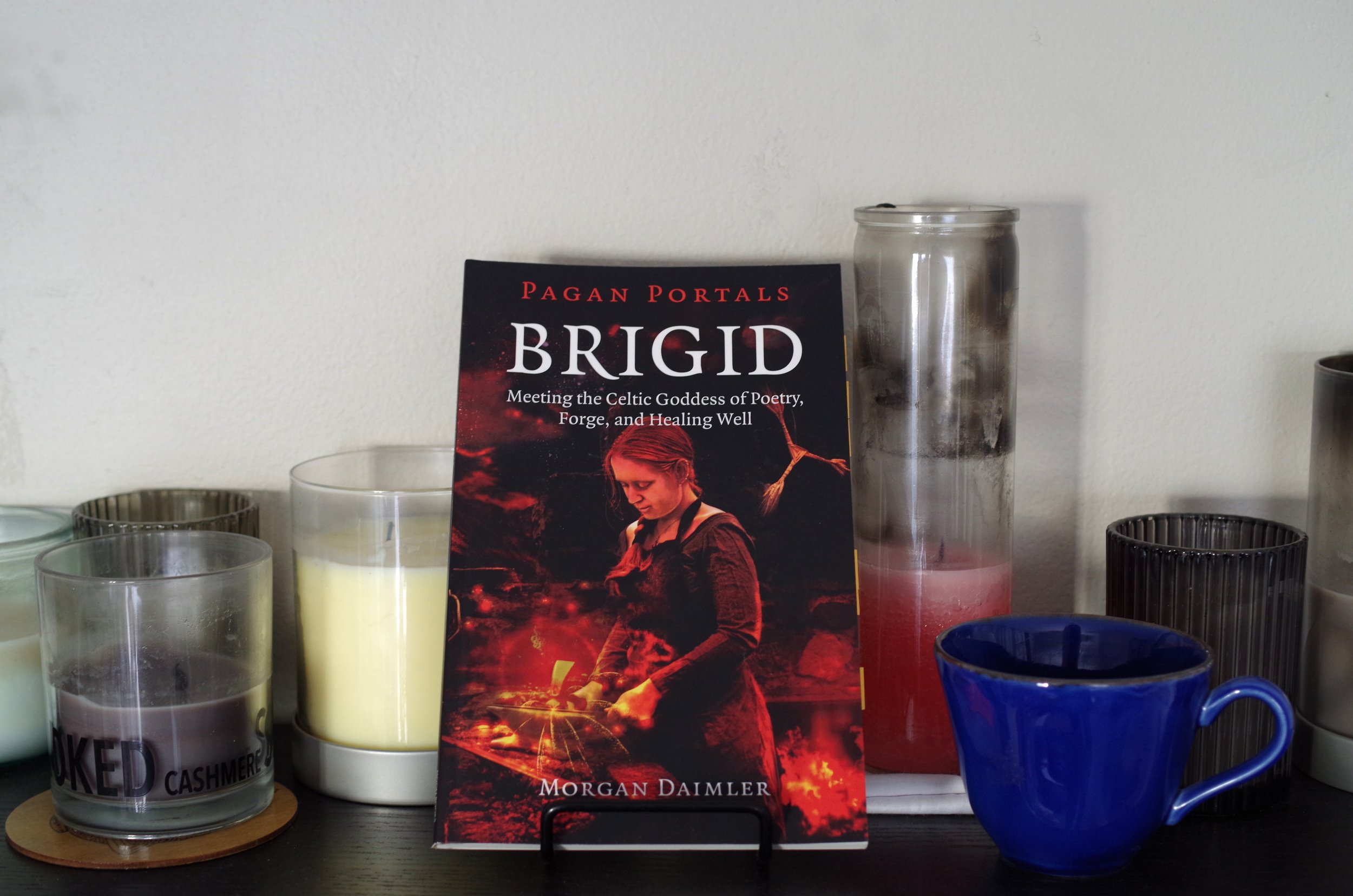The book, resting on my shrine to the Tuatha Dé, next to the pink candle dedicated to Brigid, which sits atop my blessed cloth.
Pagan Portals — Brigid: Meeting the Celtic Goddess of Poetry, Forge, and Healing Well
by Morgan Daimler, published in 2016 by Moon Books
ISBN: 978-1-78535-320-8
I’ve owned this book basically since it came out, but so far had only used it as a sort of reference, so with my new intention this year of reading and reviewing one book for each of the 8 holidays in the neopagan wheel of the year, I decided to start by reading this one all the way through.
I own quite a few Pagan Portals books at this point, and most of them are by Morgan Daimler — I really find value both in the format and in the general quality of Daimler’s research and writings. I have a certain fondness for Brigid, as she was the first Pagan Deity I really had contact with, before I even realized who she was. When I was a child I used to try to pray to the Saints the way my Irish-American Catholic father expected me to, and although oddly I didn’t hear much about St. Brigid until later, I often found comfort in a presence that I first thought was Mary but came to understand was someone else, without knowing who exactly she was. I came to associate her with a rose quartz necklace I owned, and when I later began to explore Paganism, though I stopped trying to reach out to who I thought was a Saint, I still used the piece of jewelry for protection and healing because it had become imbued with her power. One more fast forward to my second ever big public ritual as an adult, on Imbolc, and while lightly trancing I saw a Goddess I assumed was Brigid, and when she came over she identified herself as the same entity I’d been praying to all those years ago. It was a big shift for me, seeing those threads all come together. Brigid the Saint, Brigid the Goddess — or a trio of Goddesses? I think it depends a little on your viewpoint, but for me they all seem to come from the same well — or perhaps the same forge.
Daimler’s first chapter, “Meeting Brigid”, introduces us not only to the trio of Sister-Goddesses, daughters of the Dagda, but also to the three Brigids from the Ulster Cycle, with whom I was much less familiar. The three sisters, Brigid of the Healing Well, Brigid of the Forge, and Brigid of the Poets, are probably the best known trio to modern Pagans, and Daimler stresses the importance of these being sisters, not the Triple Goddess of Graves’s imagination in the form of maiden, mother, and crone. The other trio, however, are all related to a semi-historical figure from the Ulster cycle, Senchan, a judge and poet of Ulster during the kingship of Conchobar Mac Nessa: Brig Brigiu (Brigid the Hospitaller) is his mother, Brig Brethach (Brigid of the Judgements) is his wife, and Brig Ambue (Brigid of the Cowless) is his daughter. I found the section on Brig Brigiu especially interesting, as there are several similarities to the Fairy Queen I serve, whom I call Starflower: her realm is an independent place of healing and respite, and I may need to do more research about the term “brigiu” and the general context of these hostels! Daimler also notes that Brigid “does have an unusually broad range of abilities and expertise which at least indicates that she held a significant and prominent place historically.” The second chapter discusses a few more Brigids: other Celtic Goddesses in the UK and on the continent, and, yes, the Saint!
Daimler’s third chapter was the sort of excellent summary mixed with direct quotations and some original translations that I have come to expect in their work, and it’s really worth buying the book for this section alone, in my opinion. It provides a really good foundation for understanding the general appearances of Brigid in the lore, and combined with the bibliography in the back, is an excellent road map for getting started doing your own research! (Since this is one of Daimler’s earlier books, however, some of their own more recent translation volumes aren’t mentioned in the back of this one, and I really do encourage people to check those out, too.)
The fourth chapter provides some really good ideas for celebrating Imbolc, Brigid’s main holiday (which is basically concurrent with the Feast Day of St. Bride), and this is one of the sections I’d referenced frequently before. The first half of the fifth chapter discusses modern myths and practices, what we might call Shared Gnosis (as opposed to Unverified Personal Gnosis, or UPG). Reading it all the way through, though, I was struck by how much of Brigid’s lore really does revolve around livestock healing and protection as well, though, and I think I know who to petition the next time one of my rabbits has a health issue!* The second half of the chapter has a guided meditation script, and a personal anecdote from Morgan Daimler. I did the journey the other day for the first time, and I thought I’d share a little bit of my experience, below. Chapter six I also referenced a fair amount before: it contains a lot of useful prayers and spoken charms. Some are original, some are translated, others are reworkings of Christian prayers to the Saint.
In general I highly recommend this book to anyone who’s interested in getting to know Brigid. The series of books are meant to be short introductions to a topic, so it would also be useful to anyone interested in Irish or Celtic Paganism generally, or as part of a reference library for a Pagan group of some sort.
* This isn’t really relevant to the book review, but because I just know someone is going to ask: yes, I have two bunnies. One is small and white, one is large and orangey-brown, and the small one has periodic issues with GI stasis, likely due to dwarfism genetics.
The second journey I ever did to Brigid (as far as I can remember) was a guided meditation to a farm where I met not one Brigid, and not three Brigids, but four. The Healer at the Well, the Smith in the Forge, and the Poet in the House. This time, on this meditation, I met seven.
Upon entering the farmhouse this time, I found myself in the presence of a woman who seemed younger than myself, standing and sway-bopping slightly as she nursed an infant. Brigid Ambue, she said to call her, Brigid the Cowless, and explained that the child was an orphan, and that no one in the world had less than an orphan less than a moon cycle old. She sent me into the kitchen, where I met a woman old enough to be my grandmother. The older woman was standing by a stove that was a bit old fashioned but still clearly a modern gas range, stirring a pot of porridge. Brigid Brethach, she called herself: Brigid the Judge. We spoke for a while, and then a woman almost as old as my mother entered, and introduced herself as Brigid Brigiu, Brigid the Hospitaller. She then took me out the back door, and we went around to visit the three I had expected. Brigid the Healer was at the well, and looked much the same as I remembered. So did Brigid the Smith, at the forge. Instead of in the house, this time Brigid the Poet was in a small shack, like a shepherd’s hut, past a field and towards the treeline, and she emerged to greet us as we came near. Satisfied, Brigid the Hospitaller then left me, and I began to make my own way back towards the house. On my way I met the one I first called Brigid the Tiny, who later revealed to me that she was the Saint, much younger than the others here and therefore in the guise of a girl of about nine. As in that earlier journey, she had me do a few farm chores before I left, and then saw me out the gate in the fence she closed behind me as I went. With each meeting I had given the Brigid a small vial of something pertaining to her craft, except the little Saint – she wished for nothing but a bit of companionship and help with her chores.


